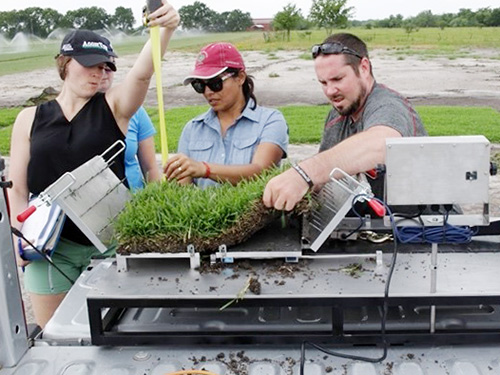Texas A&M AgriLife Research’s Cobalt St. Augustine ready for production
Hybrid turfgrass meets drought resistance, shade tolerance, dark-green color demands
The latest turfgrass developed by Texas A&M AgriLife Research will be the most drought-resistant St. Augustine variety on the market, researchers said.
“It creates a healthy lawn with less frequent irrigation, saving increasingly important water resources,” said Ambika Chandra, Ph.D., AgriLife Research professor of turfgrass breeding and genetics, Dallas, in the Department of Soil and Crop Sciences.
The hybrid turfgrass, marketed under the trademark Cobalt, is suited for broad commercial and residential use. It is a darker green and tolerant to shade compared with other St. Augustine varieties.
Cobalt is the product of 20 years of research and development, Chandra said. Developed as DALSA 1618, the new variety has been licensed for production by Sod Solutions of South Carolina.
Cobalt was created using embryo-rescue technology to achieve drought and pest resistance from one parent plant, and deep color, cold tolerance and shade tolerance from the other.
The new turfgrass boasts a good establishment rate, and its wide stolons bear wide grass blades. Cobalt is winter hardy to USDA cold hardiness zone 8a and has withstood temperatures well below freezing.
“It consistently performs well at sites across the country,” said Tobey Wagner, Sod Solutions president. “The 2021 polar vortex, when the air temperature dropped as low as 1 degree Fahrenheit, was the ultimate real-life test for this grass. Cobalt survived and thrived.”
A St. Augustine to meet market demands
The newly trademarked variety was bred at the Texas A&M AgriLife Research and Extension Center at Dallas and tested across the southeast U.S. to satisfy the needs of modern markets. Those needs were determined by the St. Augustinegrass Research Group, SARG. The group, comprised of Texas’ leading turfgrass producers, also partially sponsored the development of Cobalt.
The SARG producers agreed that to be viable in today’s markets, new St. Augustinegrasses must include strong drought and disease resistance in the face of changing climates, Chandra said. They also prioritized fast-growing varieties that harvest well, producing strong, solid pieces of sod.
Eight elite turfgrasses emerged from among hundreds of crosses tested by researchers in laboratories and field evaluations. Cobalt was best of the eight.
Putting the best St. Augustines to the test
In 2018 following years of crossbreeding and evaluations, Chandra’s team planted the eight elite turfgrass lines for testing at two Texas sod farms: Kubicek Farms in the south and A-1 Turf Farm in the north.

A field trial layout allowed for sod harvesters to test how well each turfgrass line held together in sturdy sod slabs.
“A good candidate for the market needs to harvest well,” Chandra said.
Her team also evaluated the eight elite lines for disease resistance, genetic color, overall quality and drought resistance. Researchers and producers harvested the grasses three times throughout the sod production trials. The producers identified desirable traits of each turfgrass line during harvest, and the group tested the tensile strengths of each line.
The team — with Chrissie Segars, Ph.D., assistant professor in the department’s turfgrass program and Texas A&M AgriLife Extension Service state turfgrass specialist — selected four superior turfgrass lines from among the final eight.
The final four
The final four selections underwent another year of growth. Each line was planted and studied on a larger plot so the best line could provide enough stock material for commercial production. The final research also included a new trial area in Wharton, about 50 miles southwest of Houston.
Cobalt, tested as DALSA 1618, was ranked as one of the top entries for drought resistance by the warm-season grass research group of the 2015 U.S. Department of Agriculture Specialty Crop Research Initiative. Under USDA-SCRI, Cobalt was evaluated across Texas, Florida, Georgia, North Carolina and Oklahoma.
It was also evaluated by seven universities in eight environments under the 2016 National Turfgrass Evaluation Program. NTEP ranked Cobalt in its top statistical group, suggesting wide adaptation to a range of environments, Chandra said.
The future
As Sod Solutions prepares Cobalt for wholesale to producers across the U.S., a second experimental grass from the study’s final four, DALSA 1318, will undergo more years of evaluation.
That turfgrass’ excellent establishment rate sees it growing in faster than any other grass, including Cobalt, though Cobalt’s drought resistance is superior.
In the meantime, Chandra said, the St. Augustine market receives a major boost in desirability and performance with the introduction of Cobalt.
“A customer seeking a great-looking St. Augustine grass to plant in some shade can now start with Cobalt,” Chandra said. “And it comes with significantly better drought resistance, which means reduced watering. It hits all the marks that producers have asked of in a new St. Augustine.”
At the same time, Wagner said he anticipates international excitement around Cobalt.
“Dr. Chandra and the SARG group should be extremely proud of the work and research put into this unique and outstanding St. Augustine grass,” Wagner said. “We are thrilled to bring this grass to the market.”
Sod farms interested in Cobalt seed stock should contact Sod Solutions.



